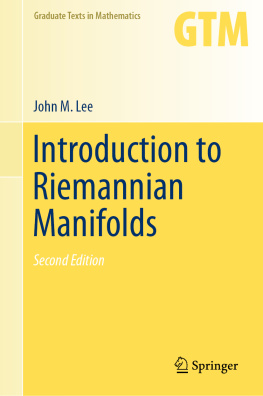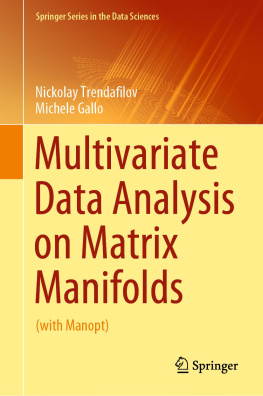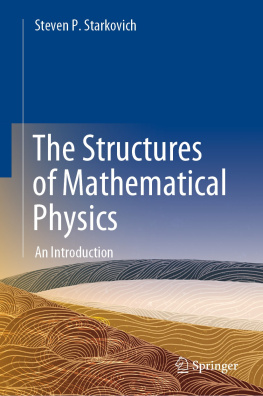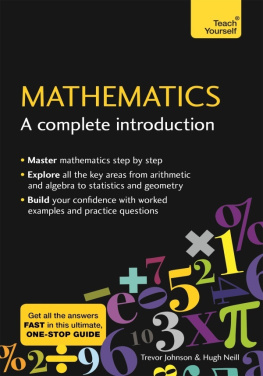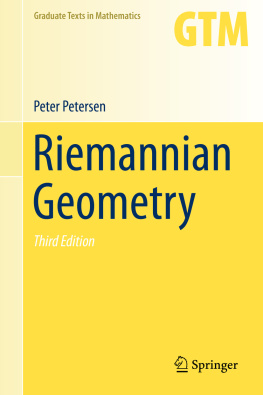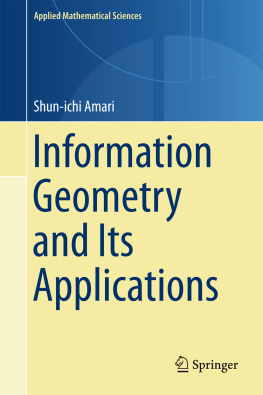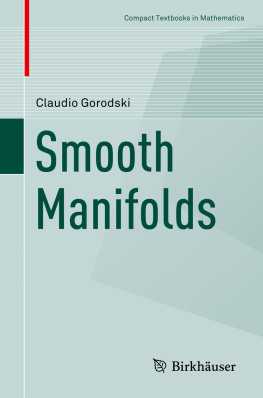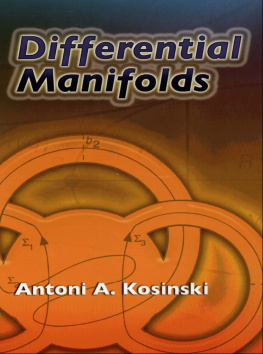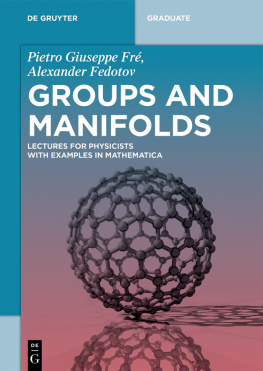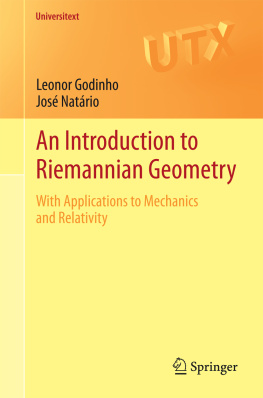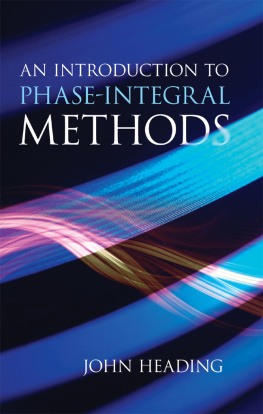John M. Lee - Introduction to Riemannian Manifolds (Graduate Texts in Mathematics)
Here you can read online John M. Lee - Introduction to Riemannian Manifolds (Graduate Texts in Mathematics) full text of the book (entire story) in english for free. Download pdf and epub, get meaning, cover and reviews about this ebook. year: 2018, publisher: Springer, genre: Children. Description of the work, (preface) as well as reviews are available. Best literature library LitArk.com created for fans of good reading and offers a wide selection of genres:
Romance novel
Science fiction
Adventure
Detective
Science
History
Home and family
Prose
Art
Politics
Computer
Non-fiction
Religion
Business
Children
Humor
Choose a favorite category and find really read worthwhile books. Enjoy immersion in the world of imagination, feel the emotions of the characters or learn something new for yourself, make an fascinating discovery.
- Book:Introduction to Riemannian Manifolds (Graduate Texts in Mathematics)
- Author:
- Publisher:Springer
- Genre:
- Year:2018
- Rating:3 / 5
- Favourites:Add to favourites
- Your mark:
- 60
- 1
- 2
- 3
- 4
- 5
Introduction to Riemannian Manifolds (Graduate Texts in Mathematics): summary, description and annotation
We offer to read an annotation, description, summary or preface (depends on what the author of the book "Introduction to Riemannian Manifolds (Graduate Texts in Mathematics)" wrote himself). If you haven't found the necessary information about the book — write in the comments, we will try to find it.
John M. Lee: author's other books
Who wrote Introduction to Riemannian Manifolds (Graduate Texts in Mathematics)? Find out the surname, the name of the author of the book and a list of all author's works by series.
Introduction to Riemannian Manifolds (Graduate Texts in Mathematics) — read online for free the complete book (whole text) full work
Below is the text of the book, divided by pages. System saving the place of the last page read, allows you to conveniently read the book "Introduction to Riemannian Manifolds (Graduate Texts in Mathematics)" online for free, without having to search again every time where you left off. Put a bookmark, and you can go to the page where you finished reading at any time.
Font size:
Interval:
Bookmark:

Advisory Board:
Alejandro Adem, University of British Columbia
David Eisenbud, University of California, Berkeley & MSRI
Brian C. Hall, University of Notre Dame
J.F. Jardine, University of Western Ontario
Jeffrey C. Lagarias, University of Michigan
Ken Ono, Emory University
Jeremy Quastel, University of Toronto
Fadil Santosa, University of Minnesota
Barry Simon, California Institute of Technology
Ravi Vakil, Stanford University
Steven H. Weintraub, Lehigh University
Graduate Texts in Mathematics bridge the gap between passive study and creative understanding, offering graduate-level introductions to advanced topics in mathematics. The volumes are carefully written as teaching aids and highlight characteristic features of the theory. Although these books are frequently used as textbooks in graduate courses, they are also suitable for individual study.
More information about this series at http://www.springer.com/series/136

This Springer imprint is published by the registered company Springer Nature Switzerland AG
The registered company address is: Gewerbestrasse 11, 6330 Cham, Switzerland
Riemannian geometry is the study of manifolds endowed with Riemannian metrics , which are, roughly speaking, rules for measuring lengths of tangent vectors and angles between them. It is the most geometric branch of differential geometry. Riemannian metrics are named for the great German mathematician Bernhard Riemann (18261866).
This book is designed as a textbook for a graduate course on Riemannian geometry for students who are familiar with the basic theory of smooth manifolds. It focuses on developing an intimate acquaintance with the geometric meaning of curvature, and in particular introducing many of the fundamental results that relate the local geometry of a Riemannian manifold to its global topology (the kind of results I like to call local-to-global theorems, as explained in Chapter ). In so doing, it introduces and demonstrates the uses of most of the main technical tools needed for a careful study of Riemannian manifolds.
The book is meant to be introductory, not encyclopedic. Its coverage is reasonably broad, but not exhaustive. It begins with a careful treatment of the machinery of metrics, connections, and geodesics, which are the indispensable tools in the subject. Next comes a discussion of Riemannian manifolds as metric spaces, and the interactions between geodesics and metric properties such as completeness. It then introduces the Riemann curvature tensor, and quickly moves on to submanifold theory in order to give the curvature tensor a concrete quantitative interpretation.
The first local-to-global theorem I discuss is the GaussBonnet theorem for compact surfaces. Many students will have seen a treatment of this in undergraduate courses on curves and surfaces, but because I do not want to assume such a course as a prerequisite, I include a complete proof.
From then on, all efforts are bent toward proving a number of fundamental local-to-global theorems for higher-dimensional manifolds, most notably the KillingHopf theorem about constant-curvature manifolds, the CartanHadamard theorem about nonpositively curved manifolds, and Myerss theorem about positively curved ones. The last chapter also contains a selection of other important local-to-global theorems.
Many other results and techniques might reasonably claim a place in an introductory Riemannian geometry book, but they would not fit in this book without drastically broadening its scope. In particular, I do not treat the Morse index theorem, Toponogovs theorem, or their important applications such as the sphere theorem; Hodge theory, gauge theory, minimal surface theory, or other applications of elliptic partial differential equations to Riemannian geometry; or evolution equations such as the Ricci flow or the mean curvature flow. These important topics are for other, more advanced, books.
When I wrote the first edition of this book twenty years ago, a number of superb reference books on Riemannian geometry were already available; in the intervening years, many more have appeared. I invite the interested reader, after reading this book, to consult some of those for a deeper treatment of some of the topics introduced here, or to explore the more esoteric aspects of the subject. Some of my favorites are Peter Petersens admirably comprehensive introductory text [Pet16]; the elegant introduction to comparison theory by Jeff Cheeger and David Ebin [CE08] (which was out of print for a number of years, but happily has been reprinted by the American Mathematical Society); Manfredo do Carmos much more leisurely treatment of the same material and more [dC92]; Barrett ONeills beautifully integrated introduction to pseudo-Riemannian and Riemannian geometry [ON83]; Michael Spivaks classic multivolume tome [Spi79], which can be used as a textbook if plenty of time is available, or can provide enjoyable bedtime reading; the breathtaking survey by Marcel Berger [Ber03], which richly earns the word panoramic in its title; and the Encyclopaedia Britannica of differential geometry books,
Font size:
Interval:
Bookmark:
Similar books «Introduction to Riemannian Manifolds (Graduate Texts in Mathematics)»
Look at similar books to Introduction to Riemannian Manifolds (Graduate Texts in Mathematics). We have selected literature similar in name and meaning in the hope of providing readers with more options to find new, interesting, not yet read works.
Discussion, reviews of the book Introduction to Riemannian Manifolds (Graduate Texts in Mathematics) and just readers' own opinions. Leave your comments, write what you think about the work, its meaning or the main characters. Specify what exactly you liked and what you didn't like, and why you think so.

